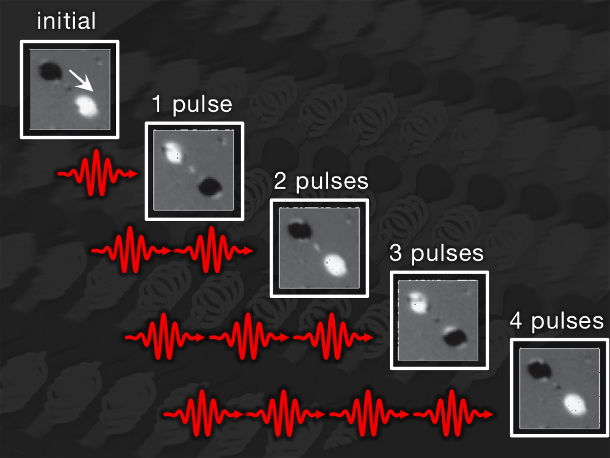Heat promises to speed up hard-disk data storage

Physicists have made a breakthrough in recording data more quickly and efficiently, through a technique that uses heat rather than an external magnetic field.

A single pico laser pulse switches magnetic state, scientists have demonstrated. Image credit: Radboud University, Nijmegen; University of York
Data is usually recorded to magnetic media such as hard drives by applying an external magnetic field that briefly inverts the polarity on the media, recording one bit each time this happens.
However, an international team led by the University of York's physics department has now managed to invert the polarity using extremely short bursts of heat — something that was not previously believed to be possible.
"Instead of using a magnetic field to record information on a magnetic medium, we harnessed much stronger internal forces and recorded information using only heat," York physicist Thomas Ostler said in a statement on Tuesday.
"This revolutionary method allows the recording of terabytes of information per second, hundreds of times faster than present hard-drive technology. As there is no need for a magnetic field, there is also less energy consumption," Ostler explained.
The technique involves sub-picosecond laser pulses that heat the magnetic media very briefly. It was previously suspected that heat may help in inverting magnetic polarity, but that it could not perform this feat on its own. Indeed, it was generally held that heat had more of a damaging than a beneficial effect on magnetic storage.
The result is so unexpected that the scientists involved are scratching their heads as to how the process had the effect it had.
"It still remains something of a mystery to us," Ostler told ZDNet UK. "We're still trying to get to grips with the full mechanism of how this thing works."
The scientists plan to use femtosecond lasers and synchrotron radiation to study the experiment, then compare the results with their own model to get a better understanding of what is going on.
As for commercialisation, one of the main problems will be putting a powerful enough laser onto the read head without drawing excessive amounts of power, Ostler said, though this is something the storage industry has been investigating for "five to 10" years.
The team, which comprises scientists from the UK, Spain, Switzerland, Ukraine, Russia, Japan and the Netherlands, published its findings in the Nature Communications journal on Tuesday.
In January, IBM revealed the results of its own research into magnetic data storage, in which it demonstrated a technique to store one bit of data using only 12 atoms. This could pave the way for magnetic storage that is ultra-small or ultra-dense, it said.
ZDNet UK's Jack Clark contributed to this story.
Get the latest technology news and analysis, blogs and reviews delivered directly to your inbox with ZDNet UK's newsletters.